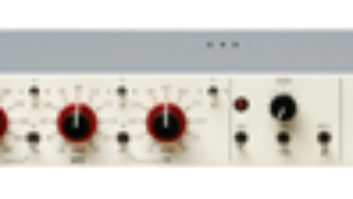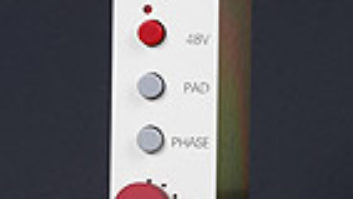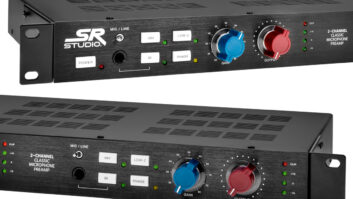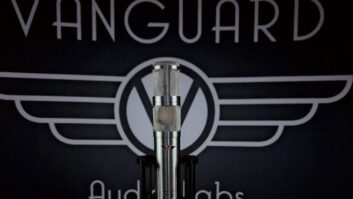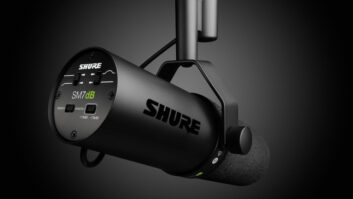“While I would consider the Ventura’s mic pre and EQ to be quite neutral, it is in no way sterile,” declares Long. The Ventura — a high-gain, low-noise, natural-sounding mic preamp coupled with extremely flexible EQ — “is one of the best recording channels I’ve encountered,” offers our senior contributor.

The Ventura combines an amazing mic preamp, a low-noise instrument input and a smooth, threeband parametric EQ that includes high/low filters into a single-rack-space channel strip. The mic pre and the EQ each have discrete signal paths with independent transformer-balanced outputs, making the Ventura extremely flexible.
Features
The Ventura is built into a 1U steel chassis. At the core of the 14 lb. box is the Carl Johnson-designed C12X discrete bipolar transistor operational amplifier. Operating on ±30 VDC rails, the C12X is a high-gain, fast-slew, stable op-amp with almost nonexistent DC offset over the audio spectrum. It employs a toroidal power transformer and is capable of driving a 50-ohm load at 50 Hz with very little current draw. The Ventura uses the C12X op-amps in the microphone preamp, instrument input amp and main output/EQ output stages. The box also features a Jensen input transformer, Cinemag output transformers and it utilizes only the highest-quality components including 1 percent metal film resistors (0.1 percent in the EQ), quality polystyrene, polypropylene, C0G and bipolar capacitors, and all gold/ silver contacts with no relays.
With the exception of the front panel’s instrument input, all I/O connectivity is located on the rear panel. This includes a microphone input via a female XLR connector, mic/instrument output via a male XLR, EQ input/insert return via a quarter-inch TRS jack, and main output via a male XLR connector. A standard IEC connector provides power input that is jumper selectable between 110 and 220VAC operation.
The mic pre is a single-stage, transformer- coupled, balanced I/O design that provides up to 72 dB of gain and includes switches for phase reverse, -20 dB pad activation, and +48V phantom power. An LED illuminates when phantom power is activated. The instrument input is single-stage, single-ended, high-impedance primarily designed for bass and guitar pickups. The Input Select switch determines whether the Mic or the Instrument signal is routed through the system. The microphone circuit has an input impedance of 1.4k ohms typical and the instrument circuit has an input impedance of 20Meg ohms nominal.
The EQ input/insert return is a direct-coupled, balanced input. Inserting a TRS quarterinch plug into the EQ Input/Insert Return jack allows for direct input to the equalizer, bypassing both the mic preamp and instrument input. The three-band parametric equalizer is activated via the EQ Switch and features 33 frequencies with three bands of overlapping ranges covering from 50 Hz to 15 KHz. Both the frequency selection and the ±12 dB boost/cut controls are step-type switches for exact recallability, and they utilize concentric controls with the inner knob controlling boost/cut and the outer knob selecting the desired frequency.
Each band includes a three-position Q switch selectable between sharp (S), wide (W) and narrow (N) providing respective Q widths of 2.4, .7 and 7.7. The low and high EQ bands are equipped with a switch that disables the Q feature changes their operation from peak to shelf. High Pass and Low Pass filter switches insert the high-pass and low-pass filters after the EQ circuit. Both filters are wonderfully musical with the 12 dB, second-order slope high-pass filter operating with a 150 Hz corner frequency and the 12 dB, second-order slope low-pass filter operating with a 9 kHz corner frequency. These filters work whether the EQ is active or not.
In Use
I’ve been using the Ventura for the last few months, and the box is truly amazing. The preamp is one of the most flexible that I’ve ever encountered. I’ve used it with dozens of different mics, and there simply isn’t a bad match. From low-gain ribbons to dynamics to high-end tube mics, from what I’ve experienced, the box sounds great with every mic I tried. The 20 dB pad is useful when recording loud sound sources with high-gain microphones, although it is very disconcerting that it makes a loud pop when switched on.
During various tracking sessions, I used the channel to record kick (using a AKG D112), snare (using a Heil PR20), hi-hat (using a Royer SF-1A) and had fantastic results in every instance. The instrument input is amazing on bass guitar, and a pair of Venturas would be fantastic for recording stereo keyboard. I used the Ventura to record electric guitar with both Royer R-101 and Heil PR31BW microphones and had great results in both instances. I’ve never heard more low-frequency clarity with the R-101 than with the Ventura.
I used the Ventura along with a sE RN17 to record acoustic guitar and had wonderful results. My favorite was using the Ventura along with a Sony C-800G to record vocals. The channel performed superbly, and in this instance (as was the case with acoustic guitar) I had delightful results utilizing the high-pass filter. With a corner frequency of 150 Hz, I was fearful that the filter would be so high that it would actually dig into the tone of the instrument or voice it was being applied to but with the smooth, natural rolloff, that wasn’t the case at all.
In every instance I found the EQ to be wonderfully musical with a more than adequate selection of frequencies provided to finesse a signal into the desired outcome. I enjoyed the EQ so much that I routinely utilized it (primarily on lead vocals and bass guitar) while mixing and since the adjustments are all made with step-type switches, there’s never any question about returning to my precise settings when recalling a mix.
Maybe I keep my studio too dark, but I’m getting tired of these blinding blue LEDs and the Ventura unfortunately uses one of these to signify that the unit is powered on. The solution? A small piece of tape over it. I’ll quit complaining.
The EQ on the Ventura is simply spectacular, and it maintains its musicality regardless of the extremities to which it can be pushed (unlike most EQs). I love having the ability to simultaneously use the mic pre from the Ventura on one sound source while using the EQ on another. While recording a guitar/vocal, I used the mic pre on the vocal (with a Sony C-800G) while simultaneously using the Ventura’s EQ on the acoustic guitar (with an sE RN17 into a Gordon Audio mic pre), and the results were fantastic.
The Ventura has the appearance of being completely road-worthy making it a perfect upgrade contender for live sound touring situations where an engineer wants to utilize a high-quality mic pre and EQ for the lead vocal and/or primary instruments.
While I would consider the Ventura’s mic pre and EQ to be quite neutral, it is in no way sterile. Between the mic pre’s almost nonexistent noise floor and the sound-shaping potential of the EQ, this box is one of the best recording channels I’ve encountered. I only wish A-Designs had included a compressor in the chain as I’d love to hear their take on the perfect recording channel compressor.
Summary
As of late, self-contained channel strips are becoming more and more commonplace in today’s recording studios, and the A Designs Ventura is an excellent option for someone wanting a high-gain, low-noise, natural-sounding mic pre coupled with an extremely flexible, fantastic-sounding EQ.
Price: $2,250
Contact: A-Designs | adesignsaudio.com
Russ Long is a Nashville-based producer engineer and mixer as well as a senior contributor to PAR. russlong.ws
